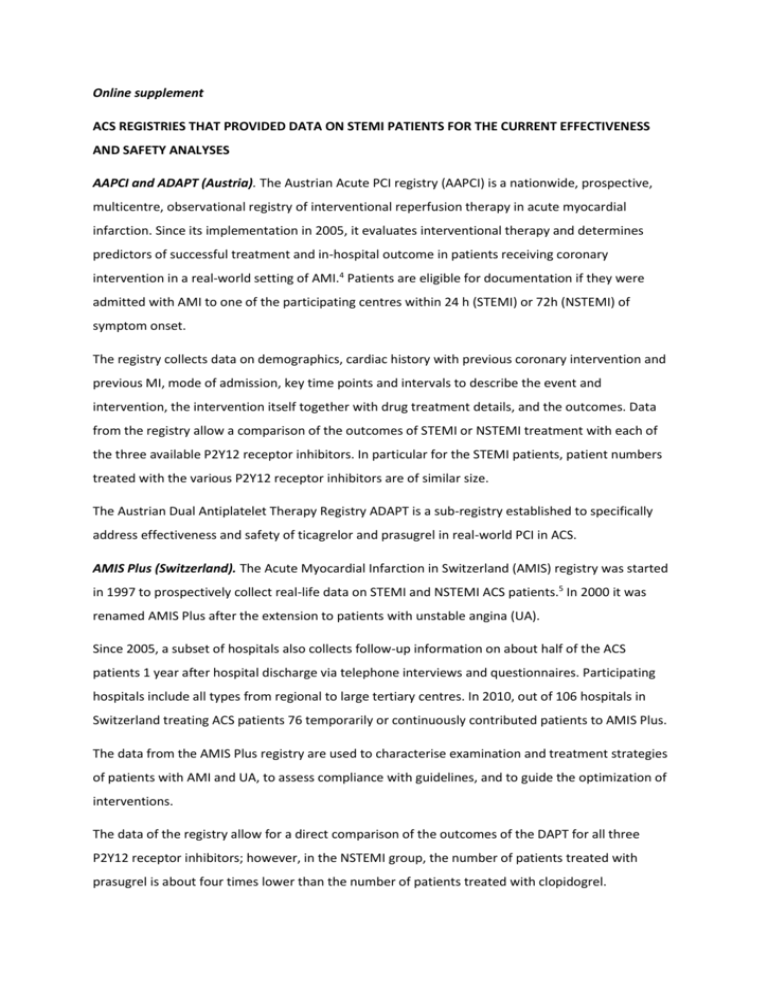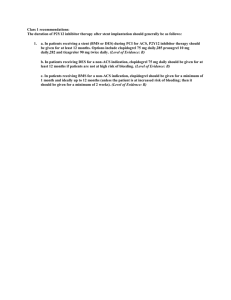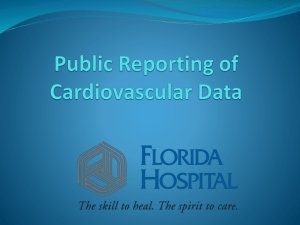Online supplement ACS REGISTRIES THAT PROVIDED DATA ON
advertisement

Online supplement ACS REGISTRIES THAT PROVIDED DATA ON STEMI PATIENTS FOR THE CURRENT EFFECTIVENESS AND SAFETY ANALYSES AAPCI and ADAPT (Austria). The Austrian Acute PCI registry (AAPCI) is a nationwide, prospective, multicentre, observational registry of interventional reperfusion therapy in acute myocardial infarction. Since its implementation in 2005, it evaluates interventional therapy and determines predictors of successful treatment and in-hospital outcome in patients receiving coronary intervention in a real-world setting of AMI.4 Patients are eligible for documentation if they were admitted with AMI to one of the participating centres within 24 h (STEMI) or 72h (NSTEMI) of symptom onset. The registry collects data on demographics, cardiac history with previous coronary intervention and previous MI, mode of admission, key time points and intervals to describe the event and intervention, the intervention itself together with drug treatment details, and the outcomes. Data from the registry allow a comparison of the outcomes of STEMI or NSTEMI treatment with each of the three available P2Y12 receptor inhibitors. In particular for the STEMI patients, patient numbers treated with the various P2Y12 receptor inhibitors are of similar size. The Austrian Dual Antiplatelet Therapy Registry ADAPT is a sub-registry established to specifically address effectiveness and safety of ticagrelor and prasugrel in real-world PCI in ACS. AMIS Plus (Switzerland). The Acute Myocardial Infarction in Switzerland (AMIS) registry was started in 1997 to prospectively collect real-life data on STEMI and NSTEMI ACS patients.5 In 2000 it was renamed AMIS Plus after the extension to patients with unstable angina (UA). Since 2005, a subset of hospitals also collects follow-up information on about half of the ACS patients 1 year after hospital discharge via telephone interviews and questionnaires. Participating hospitals include all types from regional to large tertiary centres. In 2010, out of 106 hospitals in Switzerland treating ACS patients 76 temporarily or continuously contributed patients to AMIS Plus. The data from the AMIS Plus registry are used to characterise examination and treatment strategies of patients with AMI and UA, to assess compliance with guidelines, and to guide the optimization of interventions. The data of the registry allow for a direct comparison of the outcomes of the DAPT for all three P2Y12 receptor inhibitors; however, in the NSTEMI group, the number of patients treated with prasugrel is about four times lower than the number of patients treated with clopidogrel. To date, the registry collected data from more than 51,000 patients. Belgian STEMI registry. The Belgian STEMI registry is a prospective observational multicentre study initiated in 2007. All Belgian hospitals irrespective of size and care level are eligible for participation if they have an acute care facility; currently 72 hospitals contribute data. The registry focuses on the documentation of consecutive patients with (suspected) STEMI. Pre-existing clinical conditions such as CAD or PAD are documented, apart from comorbidities such as diabetes or kidney disease. Only for a subgroup of 600 patients details on the outcomes of the different DAPT treatments are available. For these patients, more information about comorbidities such as diabetes or CAD is provided. Half of these patients were treated with ticagrelor, 170 with prasugrel and only 56 with clopidogrel. There are data for in-hospital death of the total cohort and for the patients who underwent DAPT therapy. BLITZ-4 (Italy). The “Blitz-4 Qualita’” project was initiated in 2009 and includes 163 Italian Coronary Care Units (CCUs). The goal of the project was to prospectively collect demographics, process of care and outcome measures among patients with ACS (STEMI or NSTEMI), to provide feedback to participating centres as well as specific interventions aimed at increasing compliance with the guidelines, and, ultimately, to improve the quality and standardization of myocardial infarction care. For this reason two enrolment phases were selected (September – November 2009 and FebruaryApril 2010), each followed by a feedback of both local and general performance. Overall, 5854 patients with STEMI and 5852 patients with NSTEMI were consecutively enrolled. Data collection included pharmacological and non-pharmacological indicators of performance as well as measure of excess dose of antithrombotic drugs in eligible populations. Outcome measures during the in-hospital stay, at 30 days6 and at 6 months7 were also collected. An outcome comparison between the P2Y12 receptor inhibitors was not performed as no patients received prasugrel or ticagrelor. ATACS (Germany). The ATACS (Antithrombotic Therapy in patients with Acute Coronary Syndrome) registry is a sub-registry of the ALKK coronary angiography and PCI registry. For the ATACS registry in the 30 participating hospitals between October 2009 and February 2013 specific information on timing and dosing of clopidogrel and prasugrel, risk factors for bleeding complications and timing and outcome of bleedings were added to the standard questionnaire. The registry focussed on ACS patients and the results of the STEMI patients scheduled for primary PCI, receiving a loading dose of either clopidogrel or prasugrel. (3291) outcomes until hospital discharge were reported recently.8 CZECH-2 (Czech Republic). CZECH-2 was a prospective multicentre, observational, regional survey performed in 2012, in which all 28 hospitals without catheterization availability and all 4 cardiology centres with non-stop PCI service in the 4 Czech counties (out of 13 existing counties) participated (100% hospitals in participating regions). 9 The registry documented all consecutive STEMI, NSTEMI and UA. Patients were treated with prasugrel or clopidogrel, but not ticagrelor (not available in the Czech Republic at the time of registry initiation). DIOCLES (Spain). DIOCLES study is a prospective, multicentre, registry in Spain, which documented STEMI, NSTEMI, and UA patients limited to a documentation period in 2012 and a 6-month followup.10 Except for pre-hospital ACS treatment, the registry summarises all details of enrolled patients, including complete clinical histories and comorbidities. The DIOCLES registry documents outcomes for DAPT treatment with clopidogrel or prasugrel, however, the size of the prasugrel group is a tenth of the clopidogrel group. FAST-MI (France). FAST-MI (“French Registry of Acute ST-Elevation and Non-ST-Elevation Myocardial Infarction”) is part of a programme implementing nationwide one-month surveys carried out every 5 years, since 1995. 11, 12 All types of institutions are eligible for participation (i.e., university hospitals, public hospitals, military hospitals, or private clinics, with or without on-site catheterization facilities). Several surveys were carried out, with a cohort recruited in 2010 (reported in this paper), and the next cohort due at the end of 2015. Patients were eligible for documentation if they had STEMI or NSTEMI, but not UA, and if they were admitted alive to the coronary care unit or intensive care unit within 48 hours of symptom onset. MULTIPRAC (international). MULTIPRAC (“MULTInational non-interventional study of patients with ST-segment Elevation Myocardial Infarction Treated with PRimary Angioplasty and Concomitant use of upstream antiplatelet therapy with prasugrel or clopidogrel”) was a prospective open-label noninterventional international study, performed between June 2011 and June 2013 in 25 large centres.13 Only large expert centres were selected for participation; they needed to perform at least 100 primary PCIs per year, were part of an admission network, and had a clearly defined pre-hospital treatment practice with thienopyridines in place. Only STEMI patients were eligible. As opposed to many other registries they had to receive pre-hospital prasugrel or clopidogrel loading immediately after diagnosis and prior to/during ambulance transport to a cathlab hospital for primary PCI (prehospital DAPT treatment, upstream DAPT treatment). Most of the 2053 STEMI patients were on prasugrel or clopidogrel, and only few on ticagrelor DAPT therapy. The study is one of the few reporting 1-year outcome data. Newcastle dataset (UK). The Newcastle STEMI dataset is not a typical registry, but a retrospective analysis of prospectively collected data of the Freeman Hospital, Newcastle-upon-Tyne, in the Northeast of England. Freeman Hospital is a regional tertiary centre serving a population of approximately 2 million and performing over 850 primary PCI cases per year. STEMI cases from 2010 to 2013 are reported, however without comparisons of different DAPT regimens. 14 SCAAR (Sweden). SCAAR (Swedish Coronary Angiography and Angioplasty Registry) is a prospective multicentre registry, which since 1990 documents all consecutive coronary angiographies and PCI procedures performed in Sweden.15 Data from SCAAR are reported annually.16 The registry covers all regions of Sweden and all 29 hospitals with a catheterization laboratory and enrols STEMI, NSTEMI and UA patients (in addition to angiography performed for any other reason). Data on all 3 P2Y12 receptor inhibitors are available. SPUM-ACS (Switzerland). The SPUM-ACS (Special Program University Medicine-Acute Coronary Syndromes) research network collects data since 2009 on a prospective cohort of patients hospitalised for an ACS in 4 university medical centres in Switzerland (Bern, Geneva, Lausanne and Zurich). 17 It includes STEMI, NSTEMI and UA patients. In Cohort 1 (recruited between 9/2009 and 10/2012), as per protocol and according to the ESC Guidelines, patients were treated with DAPT after PCI with clopidogrel (NSTEMI, STEMI <60 kg or >75 years or history of TIA or stroke) or prasugrel/ticagrelor (other STEMIs).18 Treatment details in hospital were not provided, but outcomes of treatment with all three P2Y12 receptor inhibitors were compared. In the STEMI group more patients received prasugrel than clopidogrel or ticagrelor.








